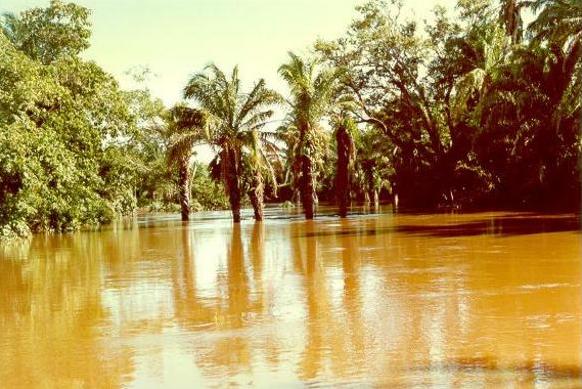|
RUNOFF DIFFUSION
TAKE 1: RUNOFF DIFFUSION
Runoff diffusion is the spreading of streamflows, longitudinally and/or
transversally, which leads to a reduction in peak flows.
Runoff diffusion is responsible for the size and magnitude of flood discharges.
What causes runoff diffusion?
There are natural and artificial causes for runoff diffusion.
In large watersheds or river basins, the flow spends most of the time in the river channels.

Red River of the North, at Grand Forks, North Dakota
In river channels, diffusion can be longitudinal and/or transversal.
Longitudinal diffusion is subject to Hayami's law.
Hayami's law states that the
coefficient of hydraulic diffusivity is directly proportional to the unit-width discharge and inversely proportional
to the prevailing channel slope.
 
Therefore, the larger the unit-width discharge and/or the smaller the prevailing channel slope, the stronger
the diffusion effect.
The transversal diffusion coefficient is usually about twice the longitudinal diffusion coefficient.

Santa Catarina river, in Monterrey, Mexico, during Hurricane Gilberto (1988)
Thus, very large unit-width discharges and/or very small slopes are extremely diffusive.
Diffusion causes spreading of the flows, increasing the chances for infiltration
and reducing runoff peaks and volumes.
Flood discharges depend on the prevailing slope, which in turn depends primarily
on the watershed or basin size, and secondarily on the stream or river cross-sectional characteristics.
TAKE 2: FLOOD ROUTING
The purpose of flood routing is to calculate the amount of runoff diffusion.
Flood routing is the calculation, in time and space, of a flood hydrograph, based on the geometric and hydraulic
stream channel characteristics.

Flood on the Chane river, Santa Cruz, Bolivia (1989)
For small unit-width discharges and/or large prevailing slopes, runoff diffusion may be effectively reduced to a negligible amount.
A flood wave that is not subject to diffusion is referred to as a kinematic wave.
In the absence of runoff diffusion, routing is based only on convection, i.e., on the travel speed
of flood discharges along the channel.
The travel speed obeys Seddon's law, which states that the wave velocity or celerity of
a certain discharge is equal to the slope of the discharge-stage rating at that discharge,
divided by the channel top width.
 
In general, a stream channel routing method must account for the Seddon and Hayami laws.
Only then will a stream channel routing method be physically based.
Unlike natural runoff diffusion, artificial runoff diffusion is produced by manmade reservoirs, which exert a diffusion effect,
spreading the flows in time and space.
Routing through reservoirs depends on the geometric characteristics of the reservoir, and on the
geometric and hydraulic properties of the outflow systems, be it closed-conduit or free-overflow spillways.

Oroville spillway, Feather River, California
Narrator: Victor M. Ponce
Music: Fernando Oñate
Editor: Flor Pérez
Copyright © 2010
Visualab Productions
All rights reserved
|